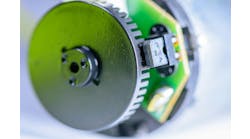There are many paths to follow for rotary and linear position sensors in machine automation, and a resolver or an encoder is often the device of choice. Certainly the device must work within the intended environment and connect to the controller, but some of the basics in selecting resolvers and encoders revolve around response time, resolution and accuracy, all of which are driven by the application.
Encoders may win the popularity contest and provide higher-resolution solutions, but the resolver has much overlap in application, and its design makes it the more robust option.
You can use either for most typical linear or rotary feedback applications, but sometime you just need a discrete sensor.
When it comes to sensors and feedback devices, they must handle the environment where installed. Sensors need to be tough enough, and most are, but encoders are often fragile and unsealed. Clearly some are meant to be embedded and protected deep inside a motor end cap or an enclosed kiosk due to the plastic housing, ribbon cable connection and open design. A sealed metal housing with circular connectors is a much better option for the plant floor.
Take a look at motor feedback needs from a machine control prospective. The amount of feedback needed depends on the application. If the application requires more than the use of sensors to detect position, feedback devices are used to close the motor speed or position control loop.
The input signal and output signal of resolvers and encoders varies widely, as does the transducer technology used. In many cases, selecting a resolver or encoder with 1,024 pulses per revolution (ppr) or 4,096 ppr and connecting it to hardware that can handle the signal level, frequency and resulting data is all that is necessary. But sometimes a better understanding of the hardware itself helps to drive the selection.
A resolver is an analog device that can be thought of as an electromagnetic transducer. It is basically a rotating transformer configured similar to a motor. The primary input winding is the rotor, which is connected to a rotating load—the position being measured. The fixed stator includes two secondary windings, a sine and a cosine orientated 90° apart.
Just like a transformer, an ac voltage is applied to the primary winding, and a voltage is induced in the secondary windings. A proportional voltage produced in the sine and cosine secondary windings is based on the angle of rotation of the primary winding. The peak voltage of these windings varies because the rotary transformer's effective turns ratio changes during rotation. Analog-to-digital electronics convert the ratio of sine voltage output to cosine voltage output and converts it to a position or angle using the arctangent function.
A single-turn resolver acts as an absolute measurement device. Its design supplies a unique sine/cosine voltage at every angle from 0° to 360°. This is why they are used for motor commutation. For higher resolution, multi-turn resolvers are used, but the absolution positioning capability is lost.
The fact that a resolver is basically a transformer, an analog device, highlights why it is so robust. There are no onboard electronics or sensitive optic disks as found in encoders. If the application has higher overall temperature, vibration or shock load, a resolver can likely handle it where an encoder may fail. Think steel mill, motor commutation and military applications.
The design of the resolver also highlights why it’s not suitable for all applications. It takes a low ac voltage in the 400 to 10 kHz range to excite the primary winding, an analog-to-digital converter and a filter. Some not-so-basic concerns pop up related to phase lag, bandwidth and tracking time. Put simply, some resolvers are a little slow to respond to dynamic changes for a lot of reasons, so be careful when using them to close a high-speed positioning control loop.
ALSO READ: Encoders and resolvers—giving you a sense of where things are
With an encoder, there is not much more to do than make sure environmentally, electrically and mechanically it works and then carefully consider resolution and rotation speed. The encoder is a digital device, so there is little concern for the measurement dynamics a resolver may have, except keeping the electrical noise out with good cable shielding and routing. However, don't mount it to an actuator on a rocket and shoot it into space.
When it comes to resolution and accuracy, remember resolvers are analog devices and encoders are digital. Some may say the resolution of a resolver is infinite, but that is incorrect when considering what is needed for it to work in many feedback applications. The encoder uses modern manufacturing techniques that not only offer high resolution, but make each digital step of feedback very accurate.
Much is written on why a resolver is such a robust solution or how to specify an encoder, so check out the online information with the appropriate search string. Each has its place and many of your suppliers and automation vendors are happy to discuss the pros and cons.






